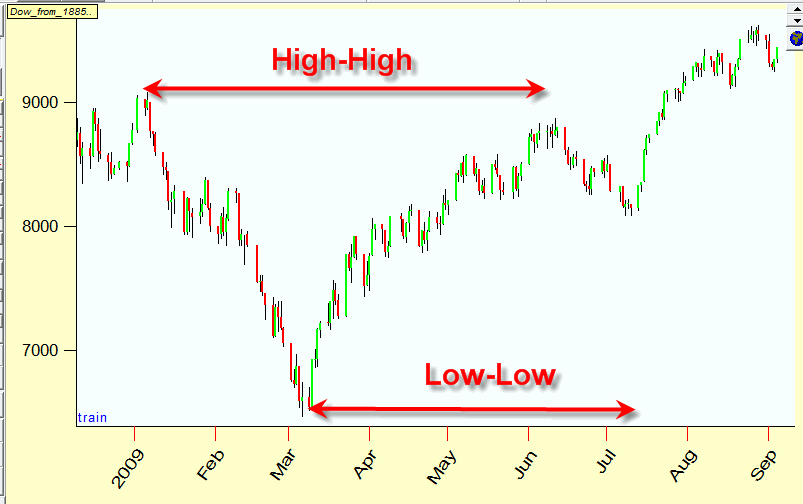
Cycles apology
Pro et Contra
I believe that the question "Do the cycles rule the stock market or not?" is not a technical question only. This is a kind of some religious question, like "Does some order exist in our Universe or is it just a game of Chaos?" or "Does the life after death exist or is this current life our only chance to be?". The main issue here is our faith, not some knowledge. If we accept that, any "pro" and "contra" arguments for these theories appear easily.
I personally have a positive vision in regards to all mentioned above issues, and in this article I would like to explain my arguments "pro" cyclic analysis' application for financial markets.
Cycles definition
The common misunderstanding arises from the very beginning, when we try to find a definition of a cycle.
How can we define the cycle in financial data? I have met many definitions; for example, a cycle can be defined as a distance between two succeeding Highs or Lows, like in this picture:

I think this is not a cycle's definition but the feature of cycles.
It is better to use this definition of a cycle: the cycle is the existence of some repeating patterns in stock market movements, and the period of the cycle is the distance between these patterns.
For example: look at these two charts - current data for 2009 (a black line) and the price chart ten years ago (a red line - DJI for the year 1999):
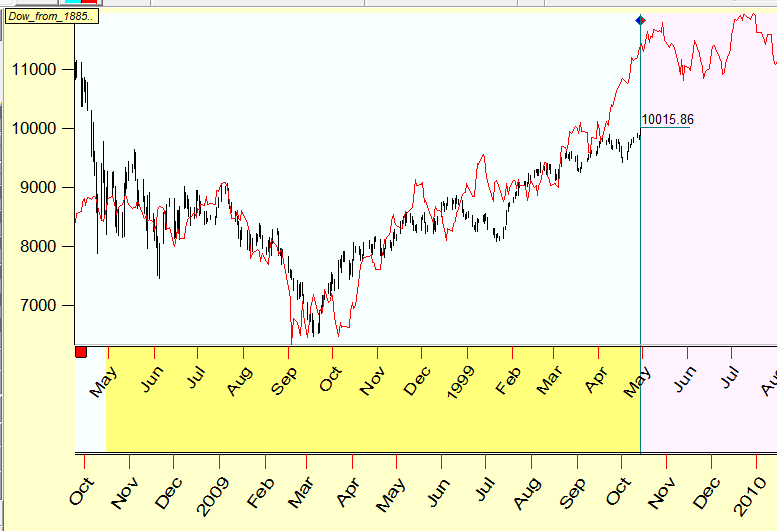
This is a fact, and this fact may be considered as some evidence that the decennial cycle plays some role on the stock market. I used here the words "some evidence" because we need to provide the full analysis comparing all other years (2008 and 1998, 2007 and 1997, etc.) before making a statement.
Overtones - enriched cycles
Cycles have many specific features. If the cycles are valid for financial markets' analysis, basic cyclic features should be present.
Let us discuss overtones.
Consider C sound. From the point of view of a physicist, what we here as C sound is just a vibration, and the frequency of this vibration is 440 oscillations per second.
From the point of view of a musician, oscillations are not ideal: C sound played by a flute sounds differently than played by a viola, and it is very different when played by a guitar. What makes the difference between these sounds? The answer is: overtones.
Physicist sees this C sound as a simple harmonic vibration, like this:

Adding one overtone, we get an enriched harmonic curve:

The more overtones, the more complicated this curve becomes. Here is the same cycle with seven additional overtones:

The overtones make the difference between the sounds produced by different musical instruments.
Cycles metrics: the World where the cycles live
Having some repeating pattern, we have a cycle. And we can measure it, its periodicity (i.e., the length of the interval of the repeated pattern). We can consider the cycle with the period of 57 calendar days, or the cycle with the period 57 trading days. It is all about how you measure the cycle's period. As an example, consider more sophisticated cycles with periods measured in degrees of Mars's longitude (keeping the same number, how about the cycle of 57 degrees of Mars's movement?). Cycles with the fixed periods of some days are rather well discussed. The last type of cycles (with the periodicity associated to planetary movements) is especially interesting, as the planets (Mars in our example) move not evenly. It is worth to study cycles calculated in this metrics; see the cycle based on degrees of Mars's longitude:
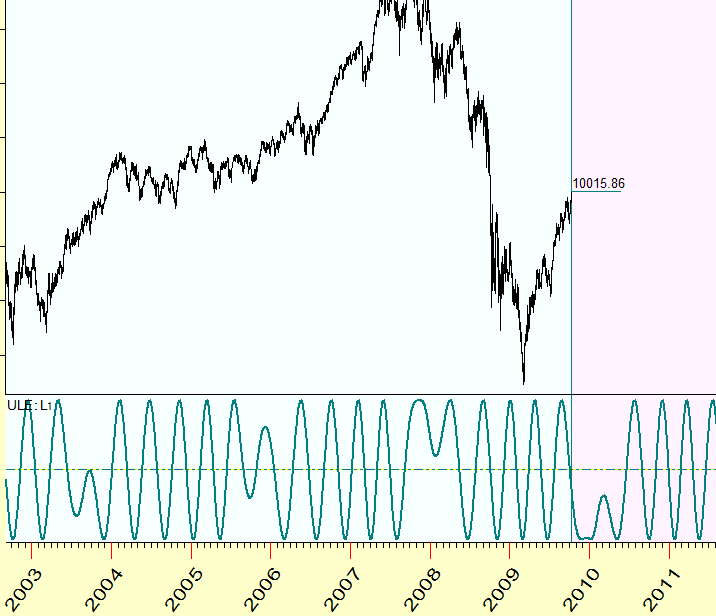
Metrics can be considered as a measure of time where these cycles live; more about this issue is here: ***
How to reveal the cycles
The basic method is the spectral analysis; this technology has been developed more than two hundred years ago. "De facto" it tries different time periods and watches how patterns with chosen periods repeat themselves in time.
The most influential/active periods form peaks on the diagram (it is called "a periodogram"):
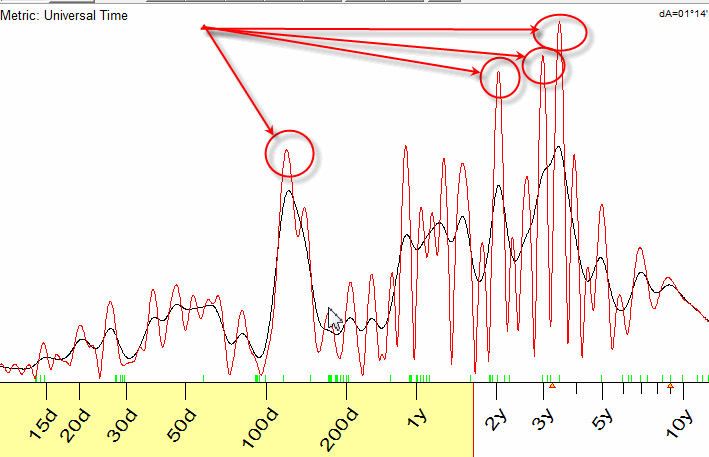
So you can easily see the most powerful cycles and draw the projection line based on those cycles.
Dominant versus Fixed cycles
This is the most argued question. The fact that there are no fixed cycles in the stock market activity has been established almost 30 years ago. However, fixed cycles still can be applied for market analysis. We just have to remember that while speaking about the effect of 120 days cycle now, we do not mean that this cycle has been active in the same manner two or five years ago (another cycles might be active at that time) .
So we have to accept the fact that cycles live their own lives - at any given moment, some cycles appear while other disappear, and our work is a work of a hunter who tries to catch a small bunch of cycles that play the most important role now. These most active cycles of the moment are called dominant cycles.
When somebody says that he/she always makes his/her forecast based on 105 days cycle (as an example), it sounds very strange in the 21st century: it means that somebody has found the cycle that lives forever.
Cycles hunting
The cyclic analysis for financial data looks very different compared to the cyclic analysis we used to see in the university textbooks: nice looking superposition of harmonic functions does not help much when applying these ideal cycles for the real financial data.
Yes. it is possible to find cycles that work for some chosen period. And it is possible to make a forecast based on such cycle/cycles. The process of finding a dominant cycle looks like a hunting, and the most important issue here is to reveal the dominant cycle as soon as it is possible. The cycle's live is restricted in time. If you reveal this cycle too late, it does not help you much because this cycle is not active already, its lifetime is over. This is a problem: the cycle may reveal itself while its lifetime is over. The fact that becomes obvious to everybody is already useless for forecasting. Efficient Market Hypothesis (EMH) works this way in the cyclic analysis.
Timing Solution software provides you the best tools for this hunting, it involves University science and traders experience in one box.
Stochastic cycle
These cycles come from Chaos theory. We can consider a stochastic cycle as a cycle of structure of the stock market behavior. Within one stochastic cycle, the behavior of the stock market, its habits, its most common patterns, its reaction on fundamental events is pretty much the same. Then something happens, the stock market behavior becomes totally different, and the experts say that the market is becoming totally unpredictable. The explanation is very simple: the stock market lives now in a different mode, a new stochastic cycle is in force.
This problem involves a lot of mathematical nuances, and I will skip them here. Technically the period of stochastic cycle can be calculated through R/S analysis.
This is how it looks like:
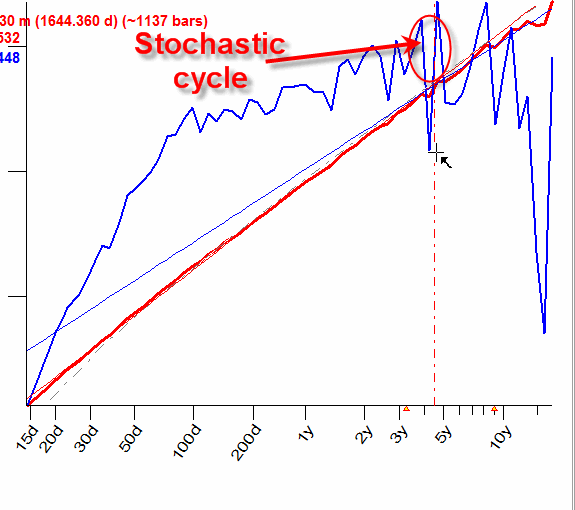
The typical period of the stochastic cycle for daily data is 4 years, i.e. one Presidential cycle or very close to Kitchen cycle. It means that we cannot trust our trading models more than 4 years, we need to review them periodically.